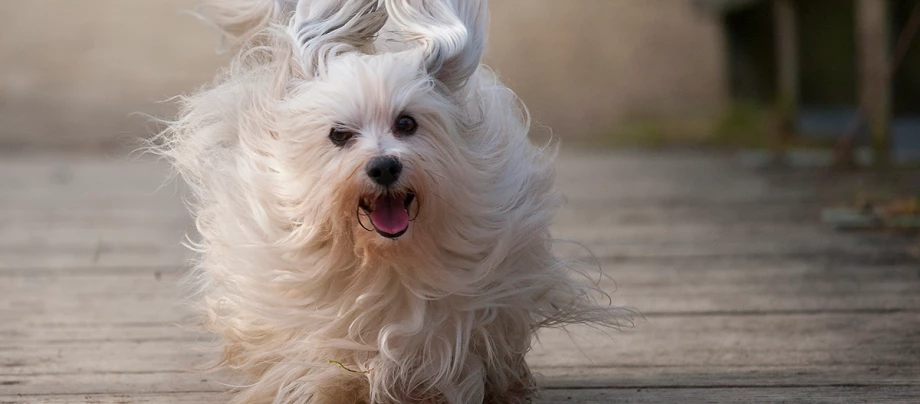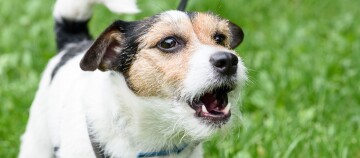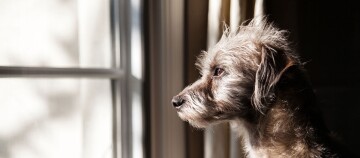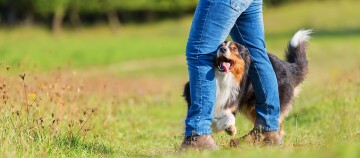Havanese – Alert and Charming with No Hunting or Protective Instincts
07.10.2022 - Reading time: 6 minutes

The Havanese with its silky soft fur and hair band above its eyes looks like a rather boring sofa dog at first glance. However, the second glance reveals a robust small dog who charms people with its clever, playful and alert manner. Long walks, exciting games and smart dog training promote the Cuban appropriately. Havanese love their couch but are no couch potatoes!
Havanese: lovable dog power from Cuba
The only recognised breed of dog from Cuba does not actually originate from the Caribbean island. The Havanese has its origin in the western Mediterranean and officially belongs to the bichon group. To date, there is disagreement as to whether the Bolognese, the Maltese or the Bichon Teneriffe, which is now extinct, was the ancestor of the Havanese. It is also possible that there was a Cuban breed of dog named Blanquito de la Habana on Cuba in the 16th century which was later crossed with Poodles to create this breed.
At any rate, one thing is certain – The Havanese would not be here today if enthusiasts of the breed had not smuggled some breeding animals from this island famous for sugar cane. Because breeding took place in the US for a long time instead of on the island of Cuba. Today, this small breed of dog is widespread throughout the world.
The character of the Havanese
The Havanese has a deep-rooted enthusiasm for its owners. It has a cheerful, friendly and affectionate nature. Cuddling is a life elixir for the little tousled dog. Many dogs of this breed do not like being alone – persistent barking, soiling and chewed items can be the result if you do not train your dog to be alone early on and in gradual steps.
Havanese love lots of exercise and are intelligent dogs that have to be challenged physically and mentally. They are alert and announce visitors reliably. In rental apartment blocks with thin walls or with a bored Havanese, this alertness can be annoying. The attentive dogs hear and report everything, including visitors to the neighbours living opposite. Occasionally, their love of barking results in altercations with neighbours and should therefore be addressed early on in training.
Aggressiveness is alien to these likeable little dogs – in fact, they tend to suggest a game if they are feeling uncertain. This behaviour, which is referred to as “fiddling”, is a displacement activity and is not really an expression of a genuine enthusiasm for a game. So it is up to you to rescue this little dog from any unpleasant encounters.
Although Havanese are very alert, they barely have any hunting or protective instincts. In some breeding lines, the little dogs do, however, demonstrate herding traits. As this should be noted in their training, talk to your breeder about this before purchase.
Training and keeping
As small and sweet as the Havanese may be, it needs clear and consistent training. These clever dogs exploit any carelessness and shape their world as they like it. This also applies when they are called to heel on a walk. It is better for you to use a lead in the beginning so that the curious little dog does not set out on adventures and ignore your calls. As a first-time dog owner, you should familiarise yourself well with the breed and then ideally seek out a dog training school straight away to have the training supported by a professional. At the school you will find out how you can control your dog’s love of barking, manage encounters with other dogs correctly and develop the training so that your dog will be happy when left alone.
A long walk in addition to the short walks is mandatory. The little dogs run eagerly along with you even on hikes or when you are on a bike or horse. Regular breaks and a cycling basket when cycling, however, are advisable so as not to tire the little dogs out.
Havenese like to be the centre of attention – they are eager to learn and always intent on pleasing their owners, so the little dog is always willing to learn something new. Whether that is a basic command or dog tricks – the main thing is that there is a whole lot of praise! Tasks that combine exercise and mental work are ideal: dog dancing, i.e. dancing with your dog, search games and dummy work are a lot of fun for your dog. In the mini class at agility, Havanese excel with their love of exercise and their talent for rapid reactions.
Caring for the Havanese
You should not underestimate the effort needed to care for your Havanese. Brush the silky fur ideally every day. Because the fur of the Havanese grows quickly, unpleasant knots quickly develop. They are primarily to be found behind the elbows and around the ears. You should check these in the course of your daily fur care, just as you check the dog’s eyes, teeth and claws.
Depending on the season, walk route and volume of dirt, it may be necessary to wash the silky Havanese fur. Because of its origin from the Caribbean, the small tousled dog is perfectly adapted to high temperatures and also copes well with hot summer weather. In winter, however, many Havanese tend to get cold quickly despite their apparently thick fur. A winter coat appropriate to the breed that sits well and keeps the dog warm is therefore essential in cold and wet weather.
Peculiarities and health
With regard to health, the Havanese is seen as a very robust breed. There are some hereditary diseases that occur occasionally in this breed of dog. These include retina dysplasia (RD), heart and lung diseases, cataract and patella luxation. Via breeding selection with the aid of health tests, you can reduce the risk of an illness in puppies. It is therefore important to discuss the breeder’s rules for breeding when selecting your breeder. Breeders who belong to the VDH (German Kennel Club) have test the animals that they breed for these illnesses.
When looked after properly, with an age-appropriate workload and appropriate feed, a Havanese can usually live up to the age of 16. With regard to feeding, pay particular attention to the slim figure of the fluffy little dogs. They tend to become overweight when they are fed too well and do not get enough exercise.
NewsletterHavanese
Breed | Havanese |
Origin | Cuba |
Classification | Society and companion dogs, bichon group |
Size | 23 to 27 centimetres |
Weight | 3.5 to 6 kilograms |
Physique | Compact, small, rectangular, slim |
Eyes | Almond-shaped, large and dark, with a happy look |
Ears | Long floppy ears with thick hair |
Coat and colour | Silky-soft, slightly curly, in all shades of beige |
Special features | Hair on the head has to be tied up to keep the eyes free |
Nature | Intelligent, active, playful, boisterous, likes to bark, alert |
Health | fundamentally robust breed with a few breed-specific hereditary illnesses such as heart and lung diseases, retina dysplasia (RD), cataract and patella luxation |
You will find the best products for your Havanese here!


